| |

> Click here to view a MAP of this tour. > Click here to view a BROCHURE of this tour.
In the early days, State Street was known as Greenleaf’s Lane and then later as Fish Street.
The Great Fire of 1811
A map of the area that destroyed sixteen acres in the downtown area. Courtesy of the Newburyport Public Library Archival Center.
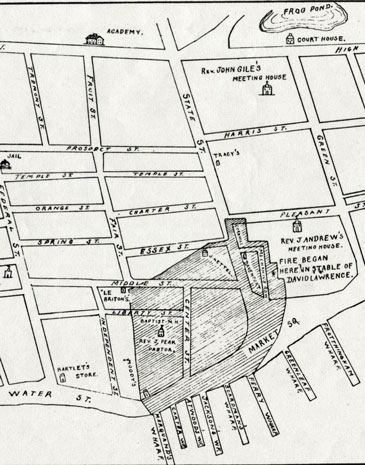 |
In her book Reminiscences of a Nonagenarian, Sarah Smith Emery (1787-1879), observed: "The memorable Friday evening, the thirty-first of May, 1811, the sun set in unclouded splendor, gilding the church spires, and gleaming upon tree tops, window panes, and the masts of the little fleet anchored at the wharves up and down the river. For the last time its rays illumined the ancient town; when it sank behind the western heights it bade a final adieu to many an antique landmark and to many a goodly heritage. The last lingering gleam died away from the old 'port,' which henceforth would only be known in tradition and song. For the last time busy feet trod those long lines of lofty warehouses; carts and drays rattled up and down the wharves; the evening stage coaches dashed up the Old Wolfe tavern; merchant and artisan turned the key, and wended their way homeward; the tea urn steamed on the luxurious board in stately mansions, and the more frugal supper was served in the dwellings of the mechanic and laborer. Little did they reckon that ere another day should dawn, each would be reduced to a perfect equality, alike homeless and penniless. That the old town of the primeval settlers and of Revolutionary fame would have passed into oblivion, that one period had endured, that henceforth a new town was to arise, a new order of things to be instituted, new customs and business to be established, new men and measures to be represented; but the old town of Newburyport, with its commerce, its prestige and aristocratic splendor had gone forevermore."
Prior to 1811, the downtown Market Square waterfront area was a hodgepodge of colonial one or two storey different style wooden buildings with shops on the first floor and owners living in the back or on the top floor. On Friday, May 31, 1811, at 9:30 p.m. a cry of "Fire!" alarmed the inhabitants and store owners. There had been little rain the past few weeks, and a northwest wind was blowing. A horse stable, on Inn Street, known as Mechanics Row, was engulfed in flames, and by the early morning hours over sixteen acres had been destroyed by the spreading fire. Nearly 250 shops and homes were destroyed between State and Fair Streets and from Middle Street to the wharf area. The commercial district included private dwellings, insurance offices, law offices, printing offices, book stores, the wharves, stores and warehouses, the Baptist Church, and ships' chandlery, dry goods, and other shops for everyday items and food. The value of the property destroyed was estimated at one million dollars.
Looking down State Street, Pleasant Street on left. After the Great Fire of 1811, brick buildings were constructed with a firewall on top of the roofs to help prevent the spread of fire. 1930s. Courtesy of the Newburyport Public Library Archival Center.
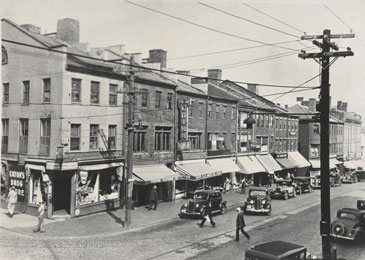 |
Three days later on Monday morning, June 3rd, people gathered to discuss the state of those who suffered by the fire, and a committee was formed on behalf of the town. The committee solicited donations from generous citizens and benevolent societies on behalf of the destitute and immediately distributed food, clothing, monies, and accommodations. Friendly assistance was given by surrounding towns in Essex County and as far away as Boston, Portsmouth, Hingham, Waltham, Attleboro, and Philadelphia. The contributions amounted to $130,000.
Today many of the brick buildings that decorate the downtown area are a result of the new building codes passed by the selectman of Newburyport and the influence of the insurance companies less than one week after the fire on June 7th. They voted that in the future all structures over ten feet high would be made of brick or stone. Until the rebuilding of the downtown area was complete years later, many low wooden structures called “ten-footers” dotted the waterfront area. Today many of the original structures built as a result of the Great Fire of 1811 are an integral part of Newburyport’s historic downtown district.
[return to top of page]
|
Newburyport Marine Society
Swett-Ilsley House, 4 High Road, Newbury where the first meeting of the Newburyport Marine Society was held on November 5, 1772. History of the Marine Society Newburyport, Bayley and Jones.
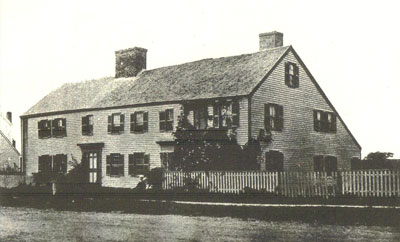 |
The Newburyport Marine Society was established in 1772; some years after the first society had been founded in Boston in 1754. The purpose of the society was "to improve knowledge of the coastline through observations and communication and to raise a common fund for the relief of members and families living in poverty." The first meeting was held in an inn located at the head of Marlboro Street, now known as the Swett-Ilsley House. The original portion of the house was built by Stephen Swett in 1690, a Newbury first settler.
In 1851 the Marine Society purchased a three story building (numbers 10-16) next to the Phenix building on State Street to establish a museum to display items from around the world. Some of the artifacts donated by members included charts of the U. S. coast survey, African sandals, costumes of the Bengalese, scarves made by natives in the Pacific Ocean islands, Chinese palm leaf fans, an opium pipe, Australian war instruments, drawings of Calcutta, a piece of red granite from St. Petersburg, Russia, an ostrich egg from Cape Town, Africa, and a Japanese book of pictures.
A history of the Marine Society was compiled by Captain William H. Bayley and Captain Oliver O. Jones in 1906. They made these observations:
Marine Society of Newburyport.
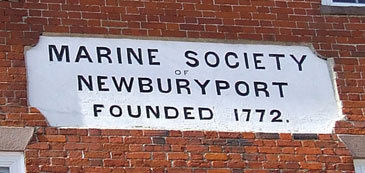 |
"It is to be regretted that no record has ever been written or preserved of the many thrilling incidents which our early members experienced, passing through the war of the Revolution, in which many of them were engaged, both on the land and on the sea, in command of privateers, and destroying many of the enemy’s vessels, often being taken prisoners, and confined in the old Mill Prison and in Bermuda, suffering great hardships, upon their return home, with the characteristic of seafaring men, ready to again start upon another cruise, to again experience capture and imprisonment. In the war of 1812, many of our number commanded privateers, and letters of marque, and in some cases, were very successful, accumulating large fortunes, which many of their descendants are enjoying at this present time."
[return to top of page]
Fowle’s News
Advertisement in the City Directory of 1871. Courtesy of the Newburyport Public Library Archival Center.
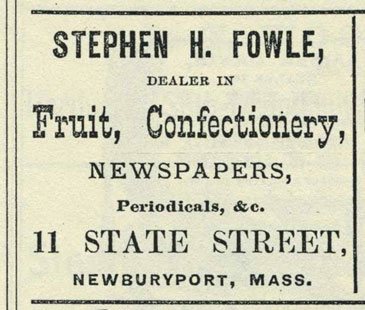 |
To this day a landmark in downtown Newburyport, Fowle’s News Company was established in 1852 by Hannah (1838-1929) and Stephen Fowle (1834-1895) and moved to its present location on State Street in 1865. In 1894, a local publication noted that for thirty years the Fowle's News Company had held an unrivaled reputation for reliability and excellence of goods. The Fowle’s establishment offered popular books, periodicals, stationery, the best brand of cigars, specialty chocolates, and Sunday and local daily papers were always available. The store also featured a soda fountain and was the headquarters of the Tabard Inn library.
Nicholas Arakelian, one time owner of Fowles News. Courtesy of Joe Callahan.
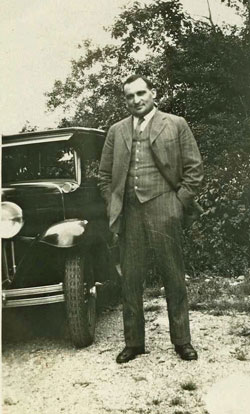 |
In the early 1890s, an Armenian family fled Turkish oppression, boarded a French freighter, and arrived in Marseilles, France. With their life savings spent, the family appealed to the Salvation Army, which contacted its American branch to find a sponsor for the family. In 1894, the family landed in New York, traveled east, and finally settled in Newburyport. The father, Donabed Arakelian, worked in a shoe factory and later opened a fruit business. His young son, Nicholas, left grammar school to find a job to help his family. Nicholas began working at Fowle’s News and spent the rest of his life working here, becoming a manager and later an owner. When Mrs. Fowle retired in 1916, she gave half the store to Mr. Arakelian, and he purchased the remaining half of Fowle’s in 1920. In 1980, Mr. Arakelian established the Mary Alice Arakelian Foundation, in memory of his beloved wife who died in 1965. Mary Alice was hired as his first bookkeeper when the federal income tax was created. The foundation continues to generously support community institutions and nonprofit organizations.
[return to top of page]
|
Joseph Moulton, Silversmith
Joseph Moulton’s store on the corner of State and Essex Streets. H. P. Macintosh photograph. Courtesy of the Historical Society of Old Newbury.
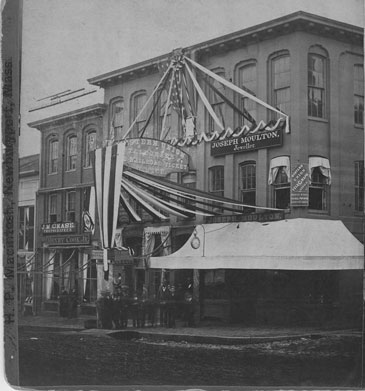 |
Joseph Moulton IV (1814-1903) was from a long line of silver and gold craftsmen. Mr. Moulton was fifth in descent from William Moulton II, who lived in Newbury in the late 1600s and made shoe buckles hammered out of silver coins. Joseph IV worked as a jeweler for many years in the downtown area where he made and sold gold beads and silverware, small gravy and sauce ladles, sugar bowls and cream pitchers, and tableware, all traditional items that were popular and had been made by the Moulton family for generations. He also traded in watches, rings, lockets, and other jewelry to supplement his business. In 1856, Mr. Moulton began making butter and fruit knives, napkin rings, and tea strainers, novelties at the time.
Joseph Moulton IV, silversmith. Courtesy of the Newburyport Public Library Archival Center.
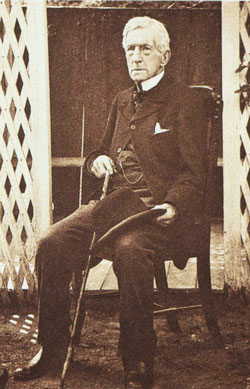 |
Mr. Moulton’s two assistants, Anthony F. Towle and William P. Jones, who had been apprentices in his father’s shop, crafted most of the silverwork. As time passed, demand increased for the new ware, plated silver, and Mr. Moulton gradually showed less interest in the crafting of handmade silverware. However, Mr. Towle and Mr. Jones preferred making the traditional silverware, and the three silversmiths parted ways. Mr. Moulton’s two sons, William V and Edward, worked alongside their father until his retirement. Edward moved on to other endeavors, and William continued to manage the business with a partner, John E. Lunt.
[return to top of page]
Threadneedle Alley
"...the Eastern Stage Company’s house; to and from its doors rattled the grandily painted stage coaches."
Sarah Smith Emery,
from Reminiscences of a Nonagenarian
Coin: 1652 - Pine Tree Shilling, probably still in use at the Wolfe Tavern. Courtesy of Mark Goodman, photographer of Coin Rarities, Wallingford, Connecticut.
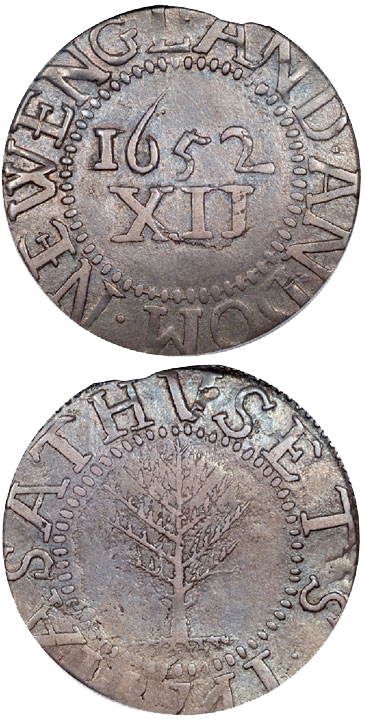 |
William Davenport (1715-1773) came to Newbury about 1738 when he was twenty-one years old. The young Davenport was a woodcarver by trade and purchased land in 1743 in the area later known as Threadneedle Alley and Mechanics Row, now Inn Street. Captain Davenport sailed up the Saint Lawrence River with other Newburyporters to capture Quebec in June of 1759. British Army officer General James Wolfe led the men in battle but was killed during the capture of Quebec. Returning to Newburyport, William Davenport engaged in woodcarving for the flourishing ship building trade and other private enterprises and made extensive alterations and additions to his own two-storey wooden house on Threadneedle Alley.
Wolfe Tavern sign. History of Newburyport. John J. Currier
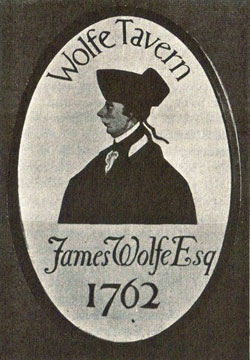 |
The Wolfe Tavern, namesake of General James Wolfe and also called Davenport's Inn opened for the entertainment of travelers in 1762. The popular place was known for its comfort, good suppers, and fine wine, and became a famous local gathering place. On Saturday evenings, men came from all around to hear the latest news and to discuss politics, theology, and the state of area agricultural crops. The Wolfe Tavern was home to the Eastern Stage Company’s headquarters, where the stagecoach stopped on its way north to New Hampshire and Maine or south to Boston. Horse stables lined Mechanics Row, and artisans worked there in the various branches of carriage-making and other trades.
Sketch of Wolfe Tavern, 1764. History of Newburyport. John J. Currier.
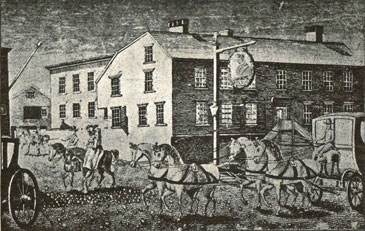 |
In Customs and Fashions of Old New England (1893), Alice Morse Earle discussed the importance of the stagecoach and the local tavern in earlier eras: "Of course there was a vast bustle and commotion on the arrival and departure of each coach, and a goodly number of passengers were deposited at the tavern. . . . It can readily be seen what a news centre such a tavern must have been, how much knowledge of the world must have been gathered by its occupants. It must be remembered that our universal modern source of information, the newspaper, did not then exist; there were a few journals, of course, of scant circulation, but of what we now deem news they contained nothing. Information of current events came through hearing and talking, not through reading. Hence it came to be that an innkeeper was not only influential in local affairs, but was universally known as the best informed man in the place, reporters, so to speak, rendered their accounts to him; items of foreign and local news were sent to him; he was in himself an entire Associated Press."
The Wolfe Tavern on Threadneedle Alley was destroyed during the Great Fire of 1811. Sons of William Davenport, Anthony and Moses, continued to manage the business. The tavern was later located on the corner of State and Temple Streets, and its last location was upper State Street on the corner of Harris Street.
[return to top of page]
|
Dr. Micajah Sawyer House
Dr. Micajah Sawyer (1737-1815), a native of Newbury, was the son of Dr. Enoch Sawyer. Micajah graduated from Harvard College in 1756 and began a medical practice in the Waterside district that later became Newburyport. He married Sibyll Farnham, with whom he had three children. Mrs. Sawyer was the daughter of Daniel Farnham (1719-1776), probably the first lawyer in Newbury, a loyalist who opposed the separation of the colonies from England. In 1766 Dr. Sawyer purchased land on State Street and built a two-storey dwelling for his family. When Pleasant Street was laid out in 1800, a portion of the estate was taken. About fifty years later, the house was raised from the level of the street, a lower storey added, and the entire building was converted into offices and stores.
Dr. Micajah Sawyer’s home on the corner of State and Pleasant Streets. Courtesy of the Newburyport Public Library Archival Center.
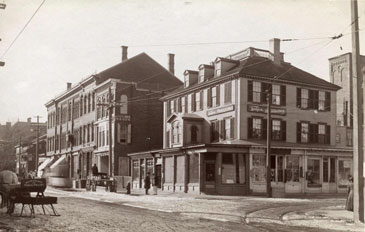 |
Honorable Eben F. Stone, a colonel in the Civil War and Newburyport mayor in 1867, spoke about Dr. Sawyer’s daughters during the 250th anniversary of the settlement of Newbury. The Sawyer family was well-known for their festivities and celebrations in the community:
"Doctor Sawyer had two uncommonly handsome daughters, distinguished far and wide for their superior beauty and style. I have seen a letter, written in 1803, by a daughter of an ex-governor of New Hampshire, and the wife of an ex-member of Congress, describing parties which she attended in Washington, during Jefferson’s administration, at the houses of the President, and of the Secretary of State, and of the French Minister, in which she says that she had seen nothing in Washington equal in style and elegance to the parties given by the Sawyer girls in Newburyport."
In 1802 Dr. Sawyer and other citizens formed the Merrimack Humane Society for the purpose of rewarding acts of valor and heroism and aiding mariners cast ashore on Plum Island. Dr. Sawyer was elected as its president, and two years later the society built three houses located on Plum Island for emergency shelter of shipwrecked seamen. Colored lights and signals were provided for the use of the keepers of the lighthouses. People who risked their lives to save others were presented with medals by the society.
[return to top of page]
The Newburyport Five Cents Savings Bank
Center of photograph, the Five Cents Savings Bank, 1874-1927. Courtesy of the Newburyport Public Library Archival Center.
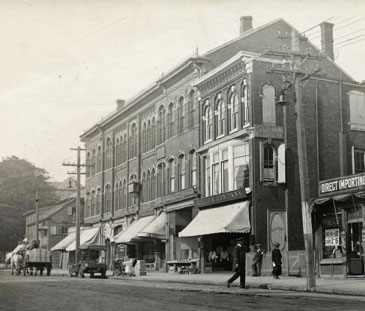 |
The Newburyport Five Cents Bank was incorporated in 1854 by several interested citizens, including John Porter, an original founder of Oak Hill Cemetery, Pastors Dr. Luther F. Dimmick and Dr. Samuel L. Spaulding, and Abolitionist and dry goods storeowner Richard Plumer. The bank opened for business on June 19th, over Joseph A. Frothingham's store on State Street. A few years later the bank moved to another building and occupied rooms over the Mechanicks Bank.
In 1873, the bank purchased a plot of land on State Street between Pleasant Street and Prince Place, and the next year a building was completed (numbers 72-80). It is the only example of High Victorian Gothic commercial architecture in town. The upper stories retain virtually all their original detail and character of Victorian gothic style. Pointed arched windows, the iron cresting at roof level, and corbelled brick detail under the cornice were all elements used to express the opulence and variety of the Victorian period. The bank, stores, and offices occupied the building, and at one time the Masonic Temple conducted services there. Over the years the ground level has been altered extensively with the renovation of storefronts. The Newburyport Five Cents Bank conducted business here until 1927, when the bank moved across the street to its present location.
Coin: 1873 with arrows 50c. Courtesy of Mark Goodman, photographer of Coin Rarities, Wallingford, Connecticut.
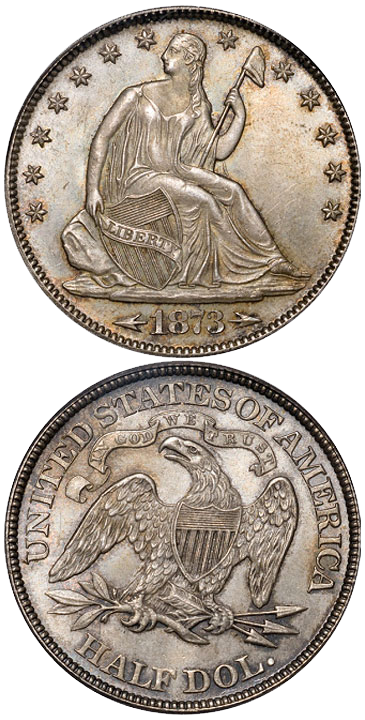 |
The Five Cents Savings Bank on the corner of State and Charter Streets and still used today. Courtesy of the Newburyport Public Library Archival Center.
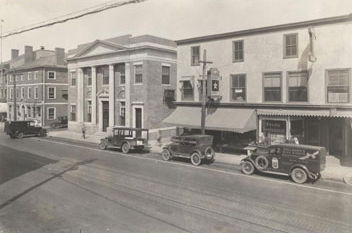 |
[return to top of page]
|
Tracy Mansion
Portrait of Patrick Tracy painted by John Trumbull, 1784. Courtesy of the Historical Society of Old Newbury.
 |
Born in Ireland, Patrick Tracy (1711-1789) began his professional life as a seaman, a skillful navigator, and became a captain and ship owner. Reverend John Lowell married Mr. Tracy and his first wife, Hannah Carter, but she and two children died a few years later. His second marriage was to Hannah Gookin, with whom he had three children.
Mr. Tracy acquired considerable wealth as a merchant and importer of foreign merchandise and was a generous benefactor of St. Paul’s Church. In 1749, Mr. Tracy bought a dwelling on Water Street near Elbow Alley and lived there until the time of his passing; the dwelling was later destroyed in the Great Fire of 1811. In 1771, Mr. Tracy purchased the house and land on State Street previously owned by Reverend John Lowell and moved the house to Temple Street. Mr. Tracy built a brick Georgian style mansion with a double hipped roof known as the Tracy Mansion for his oldest son Nathaniel Tracy. Mr. Tracy’s only daughter married Jonathan Jackson in 1772, and they began their married life in the house known as the Dexter mansion on High Street. In 1778, the home next to the Dexter house, built by Reverend Lowell’s son John Lowell, was purchased by Mr. Tracy for his youngest son John Tracy.
Portrait of Nathaniel Tracy painting attributed to Mather Brown, 1785. Courtesy of the Historical Society of Old Newbury.
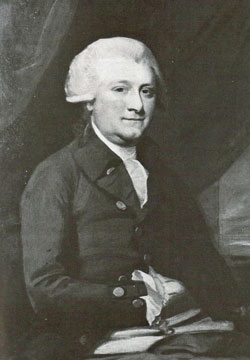 |
Nathaniel Tracy (1751-1796) graduated from Harvard College, studied a year at Yale College, and in 1772 formed a partnership with his brother John and his brother-in-law, Jonathan Jackson in the mercantile trade. Soon the Revolutionary War began, and Nathaniel Tracy fitted out a fleet of over twenty privateers during the next eight years. When the thirteen colonies declared their independence, only thirty-one vessels comprised the Continental Navy. For assistance "Letters of Marque" and commissions were issued to privately-owned ships. These privateers were outfitted as warships to capture enemy vessels. Mr. Tracy’s vessels captured about 120 ships but eventually suffered heavy losses. He was also a principal owner of more than 100 merchant vessels. By the end of the war, only thirteen of his ships remained. All the rest had been lost, shipwrecked, or captured by the enemy. At the height of his wealth, Mr. Tracy entertained lavishly at the Tracy Mansion, surrounded by an acre of gardens and fruit trees. The Tracy Mansion welcomed Thomas Jefferson as well as Colonel Benedict Arnold. By the mid 1780s most of Nathaniel Tracy's wealth had been lost, and he retired to a quiet life with his family.
Tracy Mansion on State Street, 1869, then and still the Newburyport Public Library. Luther Dame photograph. Courtesy of the Newburyport Public Library Archival Center.
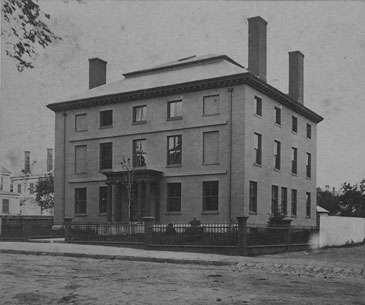 |
During Nathaniel Tracy’s financial crisis, his brother-in-law Jonathan Jackson (1743-1810) occupied the Tracy Mansion while serving as United States Marshall for Massachusetts and supervising President George Washington’s visit to New England. On October 30, 1789, Mr. Jackson welcomed President Washington, who stayed the night and departed Newburyport the next morning after a breakfast hosted by Tristam Dalton at his house across the street.
James Prince (1755-1830) served as Collector of Customs for Newburyport. In 1800 he purchased the Tracy Mansion and later lived here for thirty years. Mr. Prince first leased the mansion to Jacob Coburn who established the Sun Hotel and advertised in the Newburyport Herald on May 26, 1807. James Prince was a successful merchant and an investor in companies involved in shipping, erecting bridges, and road-building. Mr. Prince entertained General Marquis de Lafayette in 1824. He gave a dinner for the General Lafayette that was served by Prince Stetson, owner of the Wolfe Tavern.
Newburyport Sun Hotel, Copper plate by James Akin. Jacob Coburn commissioned James Akin to engrave a handbill illustrated with a view of the house, the carriage house, and the horse stalls. Courtesy of the Historical Society of Old Newbury.
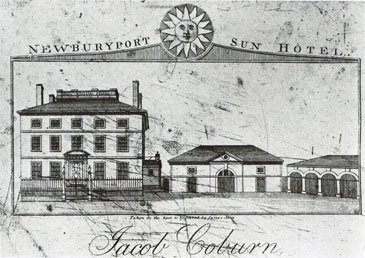 |
John Brewster, Jr. (1766-1854), an itinerant deaf-mute artist who lived in the Tracy Mansion for a short time, painted portraits of the Prince family. They can be seen at the Cushing Museum, Historical Society of Old Newbury. Prince Place, the street north of the library, was named after James Prince in the 1850s. After the passing of Mr. Prince the Tracy Mansion changed ownership several times and was home to a dentist office. In 1865, the beautiful mansion became home to the Newburyport Public Library.
[return to top of page]
Young Men’s Christian Association
Portrait of George H. Corliss. Wikipedia source.
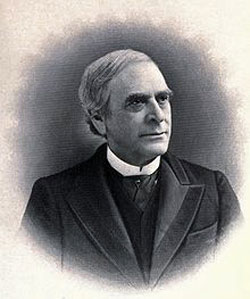 |
The Newburyport Young Men’s Christian Association was organized in 1876. Rooms were rented on State Street and later in a building on Hale’s Court and Pleasant Street. In 1890, the cornerstone was laid for a new structure on the corner of State and Harris Streets by the Reverend Thomas M. Clark, Bishop of Rhode Island, who grew up around the corner on Green Street in a house that is now the Clark Currier Inn. A celebration was held across the street in the Whitefield Congregational Society. The building was donated by the family of George H. Corliss (1817-1888) of Providence, Rhode Island, and was dedicated on April 17, 1891. The granite-based, brick and brownstone structure with arches, towers, and turrets was one of the most architecturally attractive buildings in Newburyport. In 1987, a fire destroyed the Corliss Memorial, the home of the Young Men’s Christian Association. An addition to the public library now stands in the same location.
The Young Men’s Christian Association built in 1890. Wolfe Tavern sign on the corner of Harris Street and Tracy mansion to the right. Courtesy of the Newburyport Public Library Archival Center.
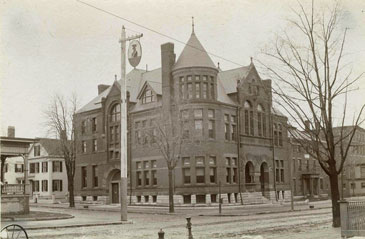 |
In 1874, Mr. Corliss and his family purchased the old Dexter Mansion on High Street from Dr. Elbridge G. Kelley, who restored the home and gardens to its original beauty. Mr. Corliss, born in New York, was a descendant of George Corliss, one of the first settlers of Newbury in 1639. Mr. Corliss was a well-known mechanical engineer and manufacturer of steam engines and pumping machinery. The Corliss steam engine was considered to have been the innovation that made steam power more economically feasible than water power. Mr. Corliss’s second wife was Emily A. Shaw of Newburyport.
[return to top of page]
|
Merrimac House and Wolfe Tavern
The last location of the Wolfe Tavern, originally established in 1762, was on the corner of State and Harris Streets. The owners of the Portsmouth, Newburyport and Boston Stage Company purchased a large three-storey brick house built in 1807 and renovated it for the accommodation of travelers. In the Newburyport Herald of June 24, 1814, a new establishment named the Merrimack Hotel advertised "lately the mansion house of General Peabody, at the sign of James Wolfe, Esq., on State Street; Stephen Hammond, landlord."
A brick home built in 1807 was renovated and the Merrimac House for travelers was established in 1814. Courtesy of the Newburyport Public Library Archival Center.
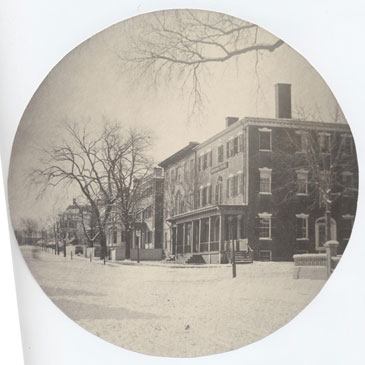 |
By 1900 there were sixty well-furnished "sleeping rooms." The dining room had a capacity of 100; there was a first class café; a barber shop; and rooms for bathing, writing, reading and billiards. It was a very popular stop for tourists and business travelers as State Street became a busy thoroughfare for journeys to southern and northern destinations. Traffic clogged the downtown area and Market Square, and these conditions gave way to the Route One bypass that was completed by 1934, diverting traffic from State and High Streets. The new rotary at the intersection of Parker and State Streets redirected traffic via a bypass between Winter and Summer Streets and over the Newburyport Salisbury Bridge.
Postcard of Wolfe Tavern. The Merrimac House was expanded and renamed the Wolfe Tavern, originally established in 1762. Courtesy of the Newburyport Public Library Archival Center.
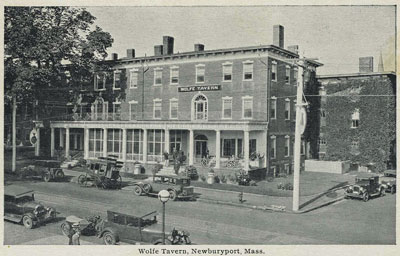 |
There were approximately twenty-five employees at Wolfe Tavern in 1900. The African American Townes family worked for a number of years at the tavern. Since the 1860s, the Townes men had worked in the community as painters, carpenters, and hatters. Lemuel and Moses Townes worked as porters at Wolfe Tavern.
Still displayed in 1953, the prominent sign with the portrait of General James Wolfe painted by Moses D. Cole after the Great Fire of 1811 is now in the possession of the Historical Society of Old Newbury. The pole that held the antique Wolfe Tavern sign was an old mast of a local ship.
After almost 300 years of service to the community and to travelers, the Wolfe Tavern closed its doors in 1951, and the hotel was razed in 1954.
[return to top of page]
|
Institution for Savings Bank
Advertisement of the City Directory of 1853. Courtesy of the Newburyport Public Library Archival Center.
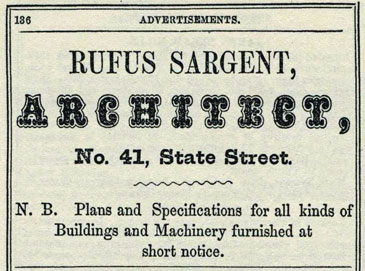 |
The third bank in the United States to be incorporated was the "Institution for Savings Bank in Newburyport and Its Vicinity" on January 31, 1820, the first being in Boston and the second in Salem, Massachusetts. At the time, the population of Newburyport was 6,852, and its business community was still recovering from the Great Fire of 1811 and the War of 1812, but there was much optimism and courage to take on this new banking venture. The incorporators were some of the most influential and prominent merchants, shipbuilders, and professionals of the town. The Newburyport Herald of April 6, 1820, reported one of "...the objects of the Institution are to afford to all of every class, but particularly to the poorer classes in the community, a safe deposit for such small sums as they can occasionally lay aside of their earnings, and where it may also be on interest, until it is wanted, and may then certainly be had with its interest."
The Institution for Savings Bank and still used today. The beautiful building was designed by Rufus Sargent and first occupied in 1871. D. T. Reed photograph. Courtesy of the Newburyport Public Library Archival Center.
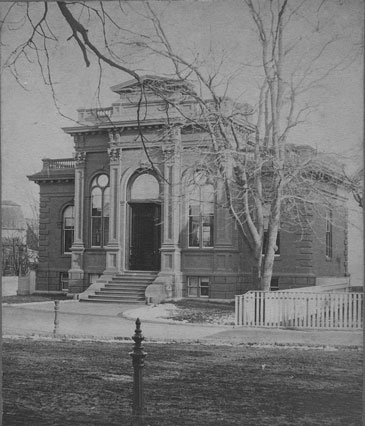 |
The bank was located in several buildings over the years: on the upper corner of State and Essex Streets in the Town Hall, on the lower corners of Pleasant and State Streets, and State and Charter Streets. In 1871 it moved to its present location. Rufus Sargent (1812-1886), a prominent local architect whose office was a few yards away on Harris Street, designed the Italianate-style bank. Tall rounded arched windows, an elevated entry door of black walnut, giant brownstone pillars, a copper balustrade and cornices, and detailing on the front façade decorate the brownstone. The architect Edwin Sherrill Dodge, a Newburyport native and son of E. P. Dodge, a shoe factory owner, conducted the rehabilitation and expansion of the building in 1903. It was during this time period that the present-day beautiful detailed interior still cherished today was created. A third expansion added a new structure to the rear of the old building in 1981. The Institution for Savings Bank is considered one of the most beautiful buildings in Newburyport history.
[return to top of page]
Coin: 1818 quarter. Courtesy of Mark Goodman, photographer of Coin Rarities, Wallingford, Connecticut.
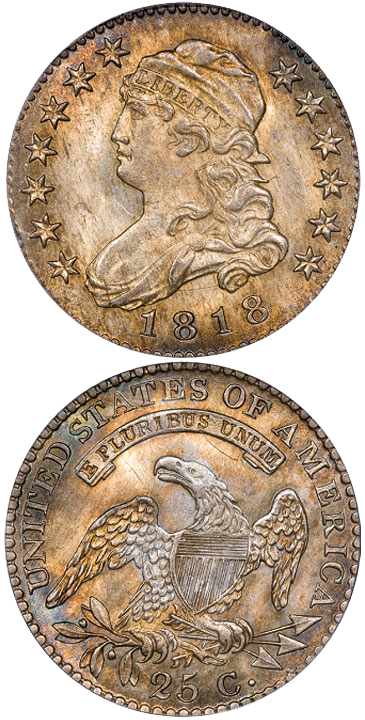 |
|
Dalton House
Michael Dalton (1709-1770) came to Newbury at a young age to work on sailing vessels. In 1734 he married Mary Little (1713-1791), daughter of Tristam Little of Newbury. In a short time, Mr. Dalton established himself as a successful merchant, joined St. Paul’s Church, and purchased a house in Market Square. In 1746 he purchased land on upper State Street and built a gambrel-roof type residence decorated in the latest Georgian style. A spacious barn and stables with an adjoining courtyard completed the homestead. The barn and stables were taken down in the late 1870s to make room for Garden Street. Mr. Dalton also purchased a large estate of 200 acres on Pipestave Hill in West Newbury to pursue his agricultural interests. As a successful merchant, he was engaged in the import and export trade of goods and owned a distillery at the foot of Queen Street, later Market Street.
The Dalton House before the 1890s. Ould Newbury. John J. Currier.
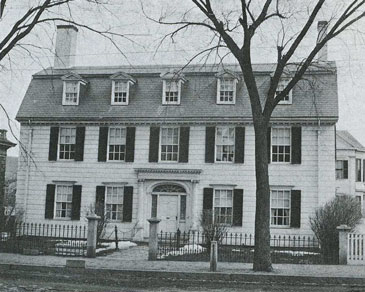 |
The State Street house and country estate at Pipestave Hill eventually passed to Michael’s son, Tristam Dalton (1738-1817) who graduated from Harvard College in the same class as John Adams. After studying law, the young Tristam returned home to work with his father in business. In 1758 he married Ruth Hooper, daughter of Marblehead merchant Robert Hooper. Mr. Dalton actively pursued town public affairs prior to the American Revolution. In 1774 he was a delegate to the Provincial Congress. Two years later he was elected to the General Court, and he served several years in the Massachusetts Senate and Legislature. Unlike many in his father’s generation who continued to support the King of England, Tristam Dalton was an ardent and patriotic supporter of the American Revolution and advocated for the adoption of the Constitution of the United States. Mr. Dalton was one of the first two elected senators to the First Congress in Massachusetts. During these years the Dalton House entertained a number of distinguished guests including George Washington and John Quincy Adams. The Pipestave Hill estate continued to be a country retreat for the Dalton family, friends and prominent guests.
Portrait of Tristam Dalton from the United States Senate Historical Office. Wikipedia source.
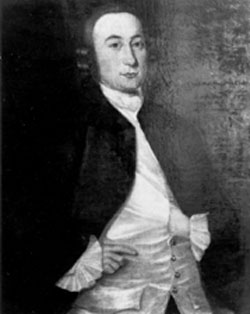 |
The Honorable Eben F. Stone of Newburyport read a paper before the Essex Institute at Salem, Massachusetts, on February 20, 1888, about the life and character of Tristam Dalton: "Physically, he was well-built, large, and robust, with a fine, erect figure, an open, benevolent, and handsome face. He was fond of music and, when young, played on the flute. Naturally refined, fond of literature, easy, affable, and dignified in his manner, he was well fitted to take a leading part in the best of New England society. His moral nature was of the highest order. Kind, generous, temperate, upright, truthful, and unselfish in the social and domestic relations, he was a model man, a dutiful son, a kind father, a good citizen, and an ardent patriot . . . take him for all is all, he was a fine specimen of an accomplished Christian gentleman of the old school, of the class which was the best product of the colonial period..."
After relocating to the new permanent seat of the federal government in Washington D. C., Mr. Dalton sold the State Street home to Moses Brown, a chaise-maker and eventual affluent merchant in town. The Dalton House stayed in the Brown family until 1897, when the private organization the Dalton Club was founded. The house built by Michael Dalton in 1746 is still home to the Dalton Club over 100 years later.
Gravestone of Fortune, servant of Tristam Dalton, located in the Newburyport Old Hill Burying Ground.
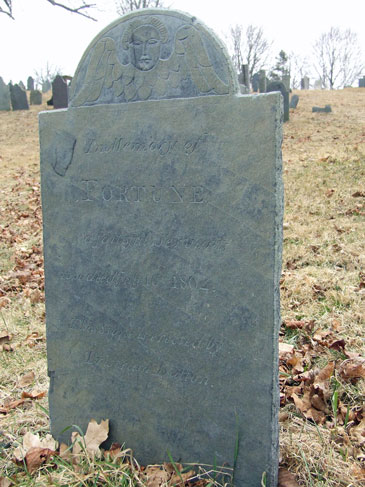 |
As did many of the earlier residents of Newburyport the Dalton family owned slaves. Mr. Dalton’s African American servants Fortune and Flora, who lived in the State Street Dalton residence, were married on August 3, 1797. They are buried in Old Hill Burying Ground. There is a short note on Fortune’s slate gravestone: "A faithful servant, died July 16th, 1804, erected by Tristam Dalton."
[return to top of page]
|
|
|

 Copyright © 2012, Newburyport Clipper Heritage Trail. All rights reserved.
Copyright © 2012, Newburyport Clipper Heritage Trail. All rights reserved.

 Copyright © 2012, Newburyport Clipper Heritage Trail. All rights reserved.
Copyright © 2012, Newburyport Clipper Heritage Trail. All rights reserved.